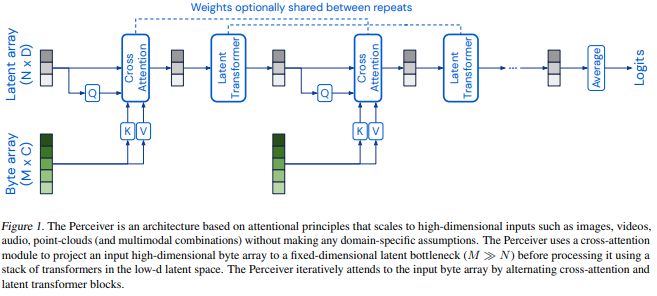Implementation of Perceiver, with support for multi-modality inputs. Fork of (lucidrains repo)[https://github.com/lucidrains/perceiver-pytorch] extended for multi-modality and support for text embedding splits chunking across layers. This repo also is closer to the Perceiver preprint because you can use GELU activation in feedforward, while Lucidrains' repo substitutes GEGLU instead. Set use_gelu to true in the MultiModalityPerceiver constructor.
MultiModalityPerceiver also provides means to customize pooling method. You can subclass perceiver_pytorch.multi_modality_perceiver.MultiModalityPerceiver and override the pool() method, or use the perceiver_pytorch.multi_modality_perceiver.MultiModalityPerceiverNoPooling implementation that returns the hidden representation without any pooling. This is useful if you need to train multitask models and want to experiment with, say, using the first 3 latent outputs to predict each a different task.
To install the Perceiver implementation with multi-modality (also includes without multi-modality):
$ pip install perceiver-multi-modality-pytorchImport with:
from perceiver_pytorch.modalities import modality_encoding
from perceiver_pytorch.multi_modality_perceiver import MultiModalityPerceiver, InputModalitySee tests/test_multimodality_perceiver.py or
from perceiver_pytorch.modalities import InputModalityWithEmbedding
from perceiver_pytorch.multi_modality_with_text_perceiver import MultiModalityWithTextPerceiverSee tests/test_multimodality_with_text_perceiver.py
To install the Perceiver implementation, follow instructions at the (lucidrains repo)[https://github.com/lucidrains/perceiver-pytorch]:
import torch
from perceiver_pytorch import Perceiver
model = Perceiver(
input_channels=3, # number of channels for each token of the input
input_axis=2, # number of axis for input data (2 for images, 3 for video)
num_freq_bands=6, # number of freq bands, with original value (2 * K + 1)
max_freq=10., # maximum frequency, hyperparameter depending on how fine the data is
depth=6, # depth of net
num_latents=256,
# number of latents, or induced set points, or centroids. different papers giving it different names
latent_dim=512, # latent dimension
cross_heads=1, # number of heads for cross attention. paper said 1
latent_heads=8, # number of heads for latent self attention, 8
cross_dim_head=64,
latent_dim_head=64,
num_classes=1000, # output number of classes
attn_dropout=0.,
ff_dropout=0.,
weight_tie_layers=False # whether to weight tie layers (optional, as indicated in the diagram)
)
img = torch.randn(1, 224, 224, 3) # 1 imagenet image, pixelized
model(img) # (1, 1000)An attractive feature of the perceiver architecture is that it can process multiple modalities of data in the same batch. This is not obvious from the perceiver forward signature shown above, but a relatively modest change can support processing video, images and audio with a single model, in one forward. This feature is demonstrated by the MultiModalityPerceiver, contributed by Fabien Campagne.
from perceiver_pytorch.multi_modality_perceiver import MultiModalityPerceiver, InputModality
image_inputs = torch.rand(size=(3, 260, 260, 3), requires_grad=True)
video_inputs = torch.rand(size=(3, 32, 260, 260, 3), requires_grad=True)
audio_inputs = torch.rand(size=(3, 44100, 1), requires_grad=True)
video_modality = InputModality(
name='video',
input_channels=3, # number of channels for each token of the input
input_axis=3, # number of axes, 3 for video)
num_freq_bands=6, # number of freq bands, with original value (2 * K + 1)
max_freq=4., # maximum frequency, hyperparameter depending on how fine the data is
)
image_modality = InputModality(
name='image',
input_channels=3, # number of channels for each token of the input
input_axis=2, # number of axes, 2 for images
num_freq_bands=6, # number of freq bands, with original value (2 * K + 1)
max_freq=4., # maximum frequency, hyperparameter depending on how fine the data is
)
audio_modality = InputModality(
name='audio',
input_channels=1, # number of channels for mono audio
input_axis=1, # number of axes, 2 for images
num_freq_bands=6, # number of freq bands, with original value (2 * K + 1)
max_freq=8., # maximum frequency, hyperparameter depending on how fine the data is
)
model = MultiModalityPerceiver(
modalities=(video_modality, image_modality, audio_modality),
depth=8, # depth of net, combined with num_latent_blocks_per_layer to produce full Perceiver
num_latents=12,
# number of latents, or induced set points, or centroids. different papers giving it different names
latent_dim=64, # latent dimension
cross_heads=1, # number of heads for cross attention. paper said 1
latent_heads=8, # number of heads for latent self attention, 8
cross_dim_head=64,
latent_dim_head=64,
num_classes=1000, # output number of classes
attn_dropout=0.,
ff_dropout=0.,
weight_tie_layers=True,
num_latent_blocks_per_layer=6 # Note that this parameter is 1 in the original Lucidrain implementation
# whether to weight tie layers (optional, as indicated in the diagram)
)
result = model({'image': image_inputs,
'video': video_inputs,
'audio': audio_inputs})While the Perceiver architecture described by [jaegle2021perceiver] could support text if text was embedded and each dimension of the embedding provided as a channel in the input, this introduces a mismatch between the text embedding dimension (typically large, 512/768 or more) and the number of channels used for video and images (typically 3 channels, one for red, green and blue), or audio (1 for mono or 2 for stereo channels). When training text embeddings from scratch, this creates an opportunity, because there should be no need for the perceiver to attend to the entire text embedding in each layer. If we split the text embedding into as many chunks as there are layers in a perceiver, we reduce how much we need to pad other modalities, and introduce a structure to the learned embeddings, were parts of the text embedding can specialize according to the needs of each layer. The perceiver implementation provided in this repo can be used to explore the question of whether splitting text embeddings across layers is beneficial (you would compare the performance of MultiModalityWithTextPerceiver with that of MultiModalityPerceiver).
@misc{jaegle2021perceiver,
title = {Perceiver: General Perception with Iterative Attention},
author = {Andrew Jaegle and Felix Gimeno and Andrew Brock and Andrew Zisserman and Oriol Vinyals and Joao Carreira},
year = {2021},
eprint = {2103.03206},
archivePrefix = {arXiv},
primaryClass = {cs.CV}
}
@misc{campagne2021textperceiver,
title = {Adapting Perceiver for learning with text modalities},
author = {Fabien Campagne},
year = {2021},
eprint = {unpublished results},
}


